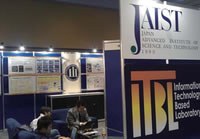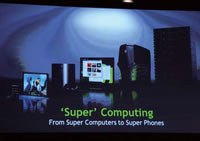K Computer News SC11 Report
During November 12-18, 2011, I attended the SC11 conference in Seattle, WA, the United States of America.
SC, formerly Supercomputing, is the international conference for high performance computing, networking, storage, and analysis. Established in 1988, it has built and brought together a diverse community to facilitate information exchange and address challenges in virtually every area of computing. SC11 attracted about 11,000 attendees, 350+ paper submissions with an acceptance rate of 20%, 23 workshops, and 349 exhibitors including 33 universities. I attended the conference to showcase our research activities in OpenMX, Green Cloud, etc. and exchange ideas with other SC11 attendees as an exhibitor of JAIST. We set up a research- content-rich booth there, with LCD screens displaying 3D simulations, posters introducing O(N) largescale first-principles calculations, and so on. As a CMSI researcher, I also participated in several sessions of interest to catch up with recent advances in the HPC area, such as Gordon Bell Prize Finalists, HPC Challenge Award, Top500, GPU computing and DFT, and performance analysis and tuning.
The K Computer shined at the conference with 3 major achievements: Gordon Bell Prize for the Peak Performance, first place in all benchmarks of the HPC Challenge Award, and the top spot in the Top500.
SC11 was not perfect, as it featured too many overlapped sessions. Also, it was commercialized to a certain extent that many attendees may not think it was truly a scientific conference. However, I think SC11 was worth attending because it made it possible to showcase our research to a diverse community. I learned a lot from the new developments and breakthroughs presented in high quality papers in the area I have been involved in, and have new ideas about what I should do next. GPU computing has been applied successfully to accelerate DFT and QCD calculations and will likely become more popular. A few petascale applications debuted, and exascale supercomputers are expected to appear within the next 10 years, most likely a hybrid design of multicore CPUs and GPUs or an integrated chip using ARM architecture. In addition, I obtained up-to-date knowledge on the next release of MPI with more support for hybrid programming and nonblocking collectives. These observations will guide me on how to develop algorithms that are scalable and compatible with future computing systems.
 |  |
|---|---|
| The booth of Japan Advanced Institute of Science and Technology (JAIST) at SC11. | The future of supercomputing is “super phones?” |
Photo : Truong Vinh Truong Duy



